Python 字符替换

在使用Python编程时,字符串替换是一种常见的操作。通过替换字符串中的特定字符或子串,可以实现文本的修改和处理。本文将详细介绍Python中字符串替换的几种常见方法,包括replace()方法、re.sub()方法和字符串切片等,并给出相应的示例代码。
replace()方法
Python中的字符串对象提供了replace()方法,用于替换指定的子串。该方法的语法格式为:
new_string = old_string.replace(old_substr, new_substr)
其中,old_string为原始字符串,old_substr为要被替换的子串,new_substr为替换后的新子串。下面是一个简单的示例代码:
# 使用replace()方法替换字符串
old_str = "Welcome to deepinout.com"
new_str = old_str.replace("deepinout.com", "Python website")
print(new_str)
运行结果:
Welcome to Python website
在上面的示例中,我们将字符串中的”deepinout.com”替换为”Python website”,并输出替换后的结果。
re.sub()方法
除了使用字符串对象的replace()方法外,还可以使用re模块中的sub()方法进行字符串替换。re.sub()方法支持正则表达式,可以实现更加灵活的字符串替换。其语法格式为:
new_string = re.sub(pattern, repl, string)
其中,pattern为需要匹配的正则表达式,repl为替换后的字符串,string为原始字符串。下面是一个示例代码:
import re
# 使用re.sub()方法替换字符串
old_str = "Visit deepinout.com for more information"
new_str = re.sub("deepinout.com", "Python website", old_str)
print(new_str)
运行结果:
Visit Python website for more information
在上面的示例中,我们使用re.sub()方法将字符串中的”deepinout.com”替换为”Python website”,并输出替换后的结果。
字符串切片
除了使用replace()方法和re.sub()方法外,还可以使用字符串切片的方式进行字符串替换。例如,通过切片的方式替换指定位置的字符或子串。下面是一个示例代码:
# 使用切片替换字符串
old_str = "deepinout.com is a great website"
index = old_str.index("deepinout.com")
new_str = old_str[:index] + "Python website" + old_str[index + len("deepinout.com"):]
print(new_str)
运行结果:
Python website is a great website
在上面的示例中,我们通过字符串切片的方式替换了字符串中的”deepinout.com”为”Python website”,并输出替换后的结果。
通过以上介绍,我们了解了在Python中进行字符串替换的几种常见方法,包括replace()方法、re.sub()方法和字符串切片。在实际应用中,根据具体的需求选择合适的方法进行字符串替换是十分重要的。
 极客笔记
极客笔记